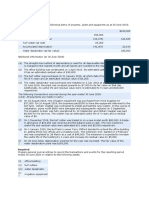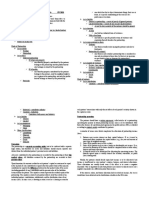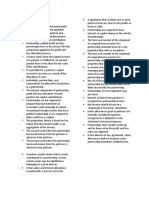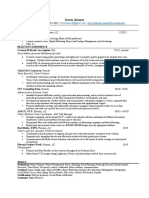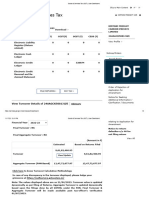Professional Documents
Culture Documents
Partnership Formation and Operation
Partnership Formation and Operation
Uploaded by
Ryan Malanum Abrio0 ratings0% found this document useful (0 votes)
19 views2 pagesPartnerships involve four key accounting considerations: formation, operation, dissolution, and liquidation. There are various types of partnerships classified according to object, liability, duration, purpose, and legality. Advantages over proprietorships and corporations include bringing greater financial capabilities, combining partner skills, and offering flexibility. Disadvantages include potential instability and unlimited liability. Upon formation, partners' capital contributions are measured at fair value and inventory is measured at lower of cost or net realizable value. Profits and losses are allocated according to partner agreement or proportionate to contributions if not specified.
Original Description:
Copyright
© © All Rights Reserved
Available Formats
DOCX, PDF, TXT or read online from Scribd
Share this document
Did you find this document useful?
Is this content inappropriate?
Report this DocumentPartnerships involve four key accounting considerations: formation, operation, dissolution, and liquidation. There are various types of partnerships classified according to object, liability, duration, purpose, and legality. Advantages over proprietorships and corporations include bringing greater financial capabilities, combining partner skills, and offering flexibility. Disadvantages include potential instability and unlimited liability. Upon formation, partners' capital contributions are measured at fair value and inventory is measured at lower of cost or net realizable value. Profits and losses are allocated according to partner agreement or proportionate to contributions if not specified.
Copyright:
© All Rights Reserved
Available Formats
Download as DOCX, PDF, TXT or read online from Scribd
Download as docx, pdf, or txt
0 ratings0% found this document useful (0 votes)
19 views2 pagesPartnership Formation and Operation
Partnership Formation and Operation
Uploaded by
Ryan Malanum AbrioPartnerships involve four key accounting considerations: formation, operation, dissolution, and liquidation. There are various types of partnerships classified according to object, liability, duration, purpose, and legality. Advantages over proprietorships and corporations include bringing greater financial capabilities, combining partner skills, and offering flexibility. Disadvantages include potential instability and unlimited liability. Upon formation, partners' capital contributions are measured at fair value and inventory is measured at lower of cost or net realizable value. Profits and losses are allocated according to partner agreement or proportionate to contributions if not specified.
Copyright:
© All Rights Reserved
Available Formats
Download as DOCX, PDF, TXT or read online from Scribd
Download as docx, pdf, or txt
You are on page 1of 2
Partnership
Four major considerations in the accounting for the
equity of a partnership:
1. Formation
Formation and 2. Operation
3. Dissolution
4. Liquidation
Operation CLASSIFICATION OF PARTNERSHIPS
1. According to object
a. Universal partnership of all present property
Article 1767. By the contract of partnership, two or b. Universal partnership of profits
more persons bind themselves to contribute money, c. Particular partnership
property, or industry to a common fund, with the
2. According to liability
intention of dividing the profits among themselves.
Two or more persons may also form a partnership a. General
for the exercise of a profession. (1665a) b. Limited
3. According to duration
ADVANTAGES & DISADVANTAGES OF a. Partnership w/ fixed term or a particular
PARTNERSHIP undertaking. b. Partnership at will.
Advantages over Proprietorships: 4. According to purpose
1. Brings greater financial capability to the business. a. Commercial or trading partnerships.
b. Professional or non-trading partnership.
2. Combines special skills, expertise and experience
of the partners. 5. According to legality of existence
3. Offers relative freedom and flexibility of action a. De jure
in decision-making. b. De facto
Advantages over Corporations: KINDS OF PARTNERS
1. Easier and less expensive to organize. 1. General Partner
2. More personal and informal. 2. Limited partner
Disadvantages: 3. Capitalist partner
1. Easily dissolved and thus unstable compared to a 4. Industrial partner
corporation.
5. Managing partner
2. Mutual agency and unlimited liability may create
6. Liquidating partner
personal obligations to a partner.
7. Dormant partner
3. Less effective than a corporation in raising large
amounts of capital. 8. Silent partner
9. Secret partner
10. Nominal partner or partner by estoppel
Type of Contribution instrument, Register with SEC, and Inventory of
Property.
1. Cash and Cash equivalents
“A corporation can enter into a contract of
Measurement: Face amount of cash and cash
partnership”
equivalent contributed (PAS 7).
“No contribution shall be valued at an amount
2. Inventory
greater than its fair value”
Measurement: Net Realizable value (estimated
“A contract of partnership doesn’t need to be in
selling price less costs to complete and sell), if
writing”
lower than cost (PAS 2).
Rule of profits and losses are allocated based on
“The division of profits and losses shall be
agreement.
according to the agreement of the partners. In the
If a partner contributes noncash asset to the absence of the stipulation, it shall be proportionate
partnership subject to mortgage, partner’s capital is to their capital contributions”
credited for the agreed value (or fair values) of the
The profit-sharing ratios will be set out in the
noncash asset less the mortgage assumed by the
partnership agreement . This will show the
partnership.
amount, usually given as a percentage of the total
Profit and loss ratio is totally independent of the profits , attributable to each partner.
partners’ ownership interests. Thus, two partners
may have ownership interests of 80% and 20% but
share profits and losses equally. The partners share in profit or losses in accordance
with their agreement .
Capital contributions of the partners are initially
measured at Fair value. One who contributes services to the partnership
rather than cash or other non-cash assets Industrial
Upon formation of the partnership, inventory is
partner.
measured using Lower of cost and net realizable
value under PAS. In the absence of stipulation as to the sharing of
profit or loss. Their respective shares would be in
Each partners capital account is credited for the
proportion to their contributions .
fair value of his Net contribution .
Cash settlements between and among the partners
“Partners are entitled to a bonus only if the
to equalize their initial capital credits are not
partnership earns a profit”
recorded in the partnership books .
“Partners are not entitled to a salary only if the
The accounting for partnerships differs from the
partnership earns profit”
accounting for sole proprietorships, corporations
A husband and wife CANNOT enter into a and cooperatives in regard to the accounting for
Universal partnership . equity.
In forming a partnership, when the capital exceeds
3,000 and personal property is invested. The legal
requirements for its establishment are a public
instrument and Inventory of Property .
In forming a partnership, when the capital exceeds
3,000 and real property is invested. The legal
requirements for its establishment are a public
You might also like
- Us Treasury Historical Asset Purchase ProgramDocument5 pagesUs Treasury Historical Asset Purchase Programpierrette100% (3)
- Unilever Comparative and Competitive AdvantageDocument19 pagesUnilever Comparative and Competitive AdvantageChong Joyee75% (4)
- Secondary DataDocument5 pagesSecondary Datakamil sheikh100% (1)
- Inspiring and Motivating IndividualsDocument2 pagesInspiring and Motivating IndividualsMuhammad Ali Asghar SandhuNo ratings yet
- Summary of William H. Pike & Patrick C. Gregory's Why Stocks Go Up and DownFrom EverandSummary of William H. Pike & Patrick C. Gregory's Why Stocks Go Up and DownNo ratings yet
- Partnership Formation NotesDocument3 pagesPartnership Formation NotesApril GumiranNo ratings yet
- WileyPlus PPEDocument9 pagesWileyPlus PPEKaiWenNgNo ratings yet
- Chapter 1 - Part 1Document2 pagesChapter 1 - Part 1clarizaNo ratings yet
- Partnership - I: "Your Online Partner To Get Your Title"Document10 pagesPartnership - I: "Your Online Partner To Get Your Title"Arlene Diane OrozcoNo ratings yet
- Accounting For Special TransactionDocument2 pagesAccounting For Special TransactionJoresol AlorroNo ratings yet
- Exercise chh7Document13 pagesExercise chh7Micah AluadNo ratings yet
- Accounting For Partnership: Part 2Document15 pagesAccounting For Partnership: Part 2Lady Fe DielNo ratings yet
- Afar NotesDocument20 pagesAfar NotesChristian James Umali BrionesNo ratings yet
- Part II Partnerhsip Corporation FAR PDFDocument101 pagesPart II Partnerhsip Corporation FAR PDFMary Joy Albandia100% (1)
- CHAPTER 12 Partnerships Basic Considerations and FormationsDocument9 pagesCHAPTER 12 Partnerships Basic Considerations and FormationsGabrielle Joshebed AbaricoNo ratings yet
- Level Up MIDTERMS AE111 112Document17 pagesLevel Up MIDTERMS AE111 112Jim ButuyanNo ratings yet
- PARTNERSHIPDocument7 pagesPARTNERSHIPoneddd439No ratings yet
- Partnership Operation and FormatinDocument2 pagesPartnership Operation and FormatinJoshua AlvarezNo ratings yet
- p2 ReviewerDocument14 pagesp2 Reviewerirish solimanNo ratings yet
- Part II Partnerhsip CorporationDocument101 pagesPart II Partnerhsip CorporationKhrestine ElejidoNo ratings yet
- Chapter 01 - Partnership Nature and ConceptsDocument11 pagesChapter 01 - Partnership Nature and ConceptsMarjorie Joyce BarituaNo ratings yet
- Partnership ConceptsDocument7 pagesPartnership ConceptsMariel TagubaNo ratings yet
- Chapter 1-Partnership FormationDocument5 pagesChapter 1-Partnership Formationbestinthesis.group11No ratings yet
- Activity 1 in Foa 2Document4 pagesActivity 1 in Foa 2Gian Rose MedenillaNo ratings yet
- Chapter 1 Partnership FormationDocument3 pagesChapter 1 Partnership FormationLyka Mae E. MarianoNo ratings yet
- Parcoac Prelim Reviewer 2Document5 pagesParcoac Prelim Reviewer 2tokyoescotoNo ratings yet
- Notes AstDocument19 pagesNotes AstMaria DubloisNo ratings yet
- Parcor ActgDocument7 pagesParcor Actgoneddd439No ratings yet
- Module 4 - Introduction To Partnership and Partnership FormationDocument14 pagesModule 4 - Introduction To Partnership and Partnership Formation1BSA5-ABM Espiritu, CharlesNo ratings yet
- Chapter 1Document19 pagesChapter 1Aria LeenNo ratings yet
- AFAR 01 - Partnership AccountingDocument7 pagesAFAR 01 - Partnership AccountingcheoreciNo ratings yet
- HO 1.1 Partnership Formation & OperationsDocument3 pagesHO 1.1 Partnership Formation & OperationsDaenielle EspinozaNo ratings yet
- Accounting For Special TransactionsDocument3 pagesAccounting For Special TransactionsJñelle Faith Herrera SaludaresNo ratings yet
- Notes For PartnershipDocument6 pagesNotes For PartnershipPankaj SinghNo ratings yet
- M1 - Partnership FormationDocument11 pagesM1 - Partnership FormationJhay MenesesNo ratings yet
- ACCT102 - Modules 1-3 ReviewerDocument31 pagesACCT102 - Modules 1-3 ReviewerkikoNo ratings yet
- 01 PartnershipDocument27 pages01 PartnershipEarl ENo ratings yet
- Module 22 (Activity 1)Document3 pagesModule 22 (Activity 1)Mylene HeragaNo ratings yet
- Characteristics of A PartnershipDocument3 pagesCharacteristics of A Partnershipskilled legilimenceNo ratings yet
- ACC 311 - Chapter 1 PartnershipDocument4 pagesACC 311 - Chapter 1 PartnershipAlyssa GuinoNo ratings yet
- Prefinal Acfar Chapter 13Document10 pagesPrefinal Acfar Chapter 13Jessica Valerie AlvarezNo ratings yet
- Module 22 (Activity 1)Document3 pagesModule 22 (Activity 1)Mylene HeragaNo ratings yet
- Partnership 2Document3 pagesPartnership 2Kenneth CuencaNo ratings yet
- Bam201 ReviewerDocument7 pagesBam201 Reviewerjireh mallariNo ratings yet
- Partnership Accounting 3. TaxationDocument5 pagesPartnership Accounting 3. TaxationQuinn SamaonNo ratings yet
- Far 2 QuicknotesDocument9 pagesFar 2 QuicknotesAlyssa Camille CabelloNo ratings yet
- Far ReviewerDocument43 pagesFar ReviewerAl Robert Angelo LoretoNo ratings yet
- Mod 1 FullDocument42 pagesMod 1 FullZAIL JEFF ALDEA DALENo ratings yet
- Lecture 2 Partnership FormationDocument58 pagesLecture 2 Partnership FormationSherwin Benedict SebastianNo ratings yet
- Basic Considerations and Formation 1Document6 pagesBasic Considerations and Formation 1EllaineNo ratings yet
- Nature and Formation of A PartnershipDocument5 pagesNature and Formation of A PartnershipEllaine IgnacioNo ratings yet
- Session 4 - Partnership AccountsDocument23 pagesSession 4 - Partnership AccountsFrederickNo ratings yet
- Spectrans M1 M2Document7 pagesSpectrans M1 M2Patricia CruzNo ratings yet
- Week 10-MusharakahDocument24 pagesWeek 10-MusharakahMuhammad Hassan Rasheed Ul HassanNo ratings yet
- Page 1 of 20 Chapter 6 - Accounting For PartnershipsDocument20 pagesPage 1 of 20 Chapter 6 - Accounting For PartnershipsELLAINE MA EBLACASNo ratings yet
- Partnership Accounting: Learning ObjectivesDocument31 pagesPartnership Accounting: Learning ObjectivesnuggsNo ratings yet
- AccountingDocument3 pagesAccountingRyan Dela Cruz CadacioNo ratings yet
- AFAR - Sir BradDocument36 pagesAFAR - Sir BradOliveros JaymarkNo ratings yet
- Chapter 5Document10 pagesChapter 5yosef mechalNo ratings yet
- ParCor Module 1 - ReviewerDocument6 pagesParCor Module 1 - ReviewerneshlgbNo ratings yet
- Partnership Study GuideDocument5 pagesPartnership Study GuidejtNo ratings yet
- Accounting For Partnership Firms - FundamentalsDocument107 pagesAccounting For Partnership Firms - FundamentalsNeerja KaushikNo ratings yet
- Par CorDocument27 pagesPar CorPam LlanetaNo ratings yet
- Afar NotesDocument6 pagesAfar NotesGio BurburanNo ratings yet
- ACC 111 CFE TOS Govt AcctgDocument2 pagesACC 111 CFE TOS Govt AcctgRyan Malanum AbrioNo ratings yet
- DEBT SECURITIES With Answer For Uploading 1Document7 pagesDEBT SECURITIES With Answer For Uploading 1Ryan Malanum AbrioNo ratings yet
- Fin ManDocument7 pagesFin ManRyan Malanum AbrioNo ratings yet
- NST 015 Up FB1 Bsar1 Pucu2Document1 pageNST 015 Up FB1 Bsar1 Pucu2Ryan Malanum AbrioNo ratings yet
- NST 015 Up FB1 Bsar1 Pucu1Document1 pageNST 015 Up FB1 Bsar1 Pucu1Ryan Malanum AbrioNo ratings yet
- Ppe Part 1 NotesDocument4 pagesPpe Part 1 NotesRyan Malanum AbrioNo ratings yet
- Working Capital Practice SetDocument12 pagesWorking Capital Practice SetRyan Malanum AbrioNo ratings yet
- Bam031 Income Taxation P2 NotesDocument8 pagesBam031 Income Taxation P2 NotesRyan Malanum AbrioNo ratings yet
- Resolution For Uniforms FinalDocument5 pagesResolution For Uniforms FinalRyan Malanum Abrio100% (1)
- Special Modes of Paymen Loss of The Thing Condonation and ConfusionDocument6 pagesSpecial Modes of Paymen Loss of The Thing Condonation and ConfusionRyan Malanum AbrioNo ratings yet
- PPE Last PartDocument8 pagesPPE Last PartRyan Malanum AbrioNo ratings yet
- FIN 081 Cash Management Additional QuestionsDocument2 pagesFIN 081 Cash Management Additional QuestionsRyan Malanum AbrioNo ratings yet
- ACC107 P1 EXAM With Key AnswerDocument9 pagesACC107 P1 EXAM With Key AnswerRyan Malanum AbrioNo ratings yet
- OBLICONDocument16 pagesOBLICONRyan Malanum AbrioNo ratings yet
- Q&a CfasDocument16 pagesQ&a CfasRyan Malanum AbrioNo ratings yet
- CFAS Reviewer TOSDocument16 pagesCFAS Reviewer TOSRyan Malanum AbrioNo ratings yet
- Re-Submisison BSBMKG623Document17 pagesRe-Submisison BSBMKG623APIWAT PHOKANCHAINo ratings yet
- Intermediate Accounting II (ACT 402)Document49 pagesIntermediate Accounting II (ACT 402)Youssef Ashraf TawfikNo ratings yet
- INVESTOR ROADSHOW Presentation: Nikola CorporationDocument27 pagesINVESTOR ROADSHOW Presentation: Nikola CorporationVineet UttamNo ratings yet
- 26-Article Text-108-1-10-20190131 PDFDocument13 pages26-Article Text-108-1-10-20190131 PDFrahmanadaaNo ratings yet
- Case 2bDocument2 pagesCase 2bStars of Knowledge - JalandharNo ratings yet
- RE Paper 08Document13 pagesRE Paper 08Elyshba NoorNo ratings yet
- 6.7.petroleum Economics and Risk AnalysisDocument43 pages6.7.petroleum Economics and Risk AnalysisBuğrahan İlginNo ratings yet
- Insead Digital MKTDocument7 pagesInsead Digital MKTkfujii2No ratings yet
- Coca-Cola Strategies - 108 - 126 Project ReportDocument43 pagesCoca-Cola Strategies - 108 - 126 Project Report2K19/BBA/108 SIDHARTH GUPTANo ratings yet
- Resume Steven Jimenez 2021Document1 pageResume Steven Jimenez 2021api-564977068No ratings yet
- I Am Sharing 'Afar Quiz' With YouDocument20 pagesI Am Sharing 'Afar Quiz' With YouAmie Jane MirandaNo ratings yet
- Maths Class Viii Practice Test 16 Direct and Inverse Proportion 1Document3 pagesMaths Class Viii Practice Test 16 Direct and Inverse Proportion 1SadiyaNo ratings yet
- Course Project in MGT6376 Operations AuditingDocument2 pagesCourse Project in MGT6376 Operations AuditingSisteretsNo ratings yet
- Promoting Sago Starch Utilization in Indonesia: September2019Document9 pagesPromoting Sago Starch Utilization in Indonesia: September2019Tryanisa Ridla AmaliaNo ratings yet
- Peter Thellusson Bank of England DirectoDocument10 pagesPeter Thellusson Bank of England DirectoStevan HaenerNo ratings yet
- CHAPTER I - StramaDocument14 pagesCHAPTER I - StramaJayson TasarraNo ratings yet
- 5 Strategic Capacity Planning For Products and ServicesDocument39 pages5 Strategic Capacity Planning For Products and ServicesRubaet HossainNo ratings yet
- 1A. Vendor Offer KIEKENS-DSH - Code2Document15 pages1A. Vendor Offer KIEKENS-DSH - Code2vivekanandakuwaitNo ratings yet
- Maroma ProjectDocument42 pagesMaroma Projectmunashe sekesoNo ratings yet
- EMEA Base Oil Price Report 14-March-23Document7 pagesEMEA Base Oil Price Report 14-March-23Yousry EltoukheeNo ratings yet
- Toyota Motor Corporation - ESG SustainabilityDocument4 pagesToyota Motor Corporation - ESG SustainabilityJerico Elumbra CabinanNo ratings yet
- Goods & Services Tax (GST) - User DashboardDocument3 pagesGoods & Services Tax (GST) - User Dashboarddurgpalsingh2023No ratings yet
- Tugas 2 Bahasa Inggris NiagaDocument2 pagesTugas 2 Bahasa Inggris NiagaBintang FazarraNo ratings yet
- Final Project: Making Imc Plan: Bộ Giáo Dục Và Đào Tạo Trường Đại Học Hoa SenDocument14 pagesFinal Project: Making Imc Plan: Bộ Giáo Dục Và Đào Tạo Trường Đại Học Hoa SenQuỳnh Lai PhươngNo ratings yet
- Advertising of Vicco Turmeric Ayurvedic CreamDocument40 pagesAdvertising of Vicco Turmeric Ayurvedic CreamChandan Parsad80% (5)






